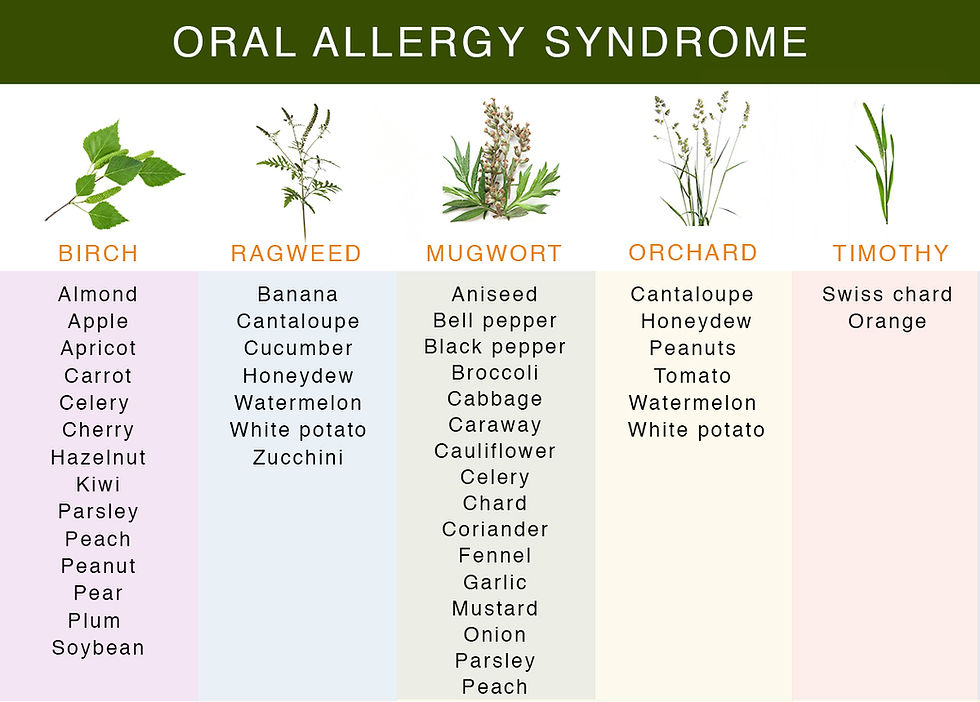Oral allergy syndrome (OAS), which is also called pollen-food allergy syndrome (PFAS or PFS), is a type of food allergy caused by uncooked fruits, raw vegetables, spices, and nuts.

OAS is seen in people who have allergies to pollens of flowering plants, trees, grasses and weeds, and is triggered by the cross-reacting protein found in both raw foods and pollen.
The immune system mistakes the protein found in certain foods for the actual pollen and produces IgE antibodies that cause the allergic reaction.
The allergic reaction is usually mild and brief, causing minor symptoms of swelling, itching or tingling of the lips, mouth or throat. Symptoms occur almost instantly after eating certain foods. Once you swallow the food, the symptoms usually go away within a few minutes. Some people develop itching, redness, or slight swelling of the hands if they peel or handle peeled raw fruits or vegetables that cause OAS, such as mangoes, apples, or white potatoes. Rarely some people can experience nausea or stomach upset.
Risk Factors
There are some factors that can make an OAS reaction more severe if present around the same time the food is eaten. The factors include consuming a very large amount of the food, vigorous exercise after eating, drinking alcohol, being sick with a stomach virus or other minor illness, being very run down or sleep-deprived, or taking narcotics or other medicines for pain or fever (such as ibuprofen or aspirin). These factors may cause the food to be taken up by the body more rapidly or processed in a different way.
Food-pollen syndrome affects most people from March through September when their pollen allergies are in season. If you eat the same offending fruit or vegetable before or after allergy season, you will likely have little to no symptoms.
Pollen-Food Triggers
BIRCH: Almond, apple, apricot, carrot, celery, cherry, hazelnut, kiwi, parsley, peach, peanut, pear, plum, and soybean.
RAGWEED: Banana, cantaloupe, cucumber, honeydew, watermelon, white potato, and zucchini.
MUGWORT: Aniseed, bell pepper, black pepper, broccoli, cabbage, caraway, cauliflower, celery, chard, coriander, fennel, garlic, mustard, onion, parsley, and peach.
ORCHARD: Cantaloupe, honeydew, peanuts, tomato, watermelon, and white potato.
TIMOTHY: Swiss chard and orange.
Usually, most pollen-food sufferers can eat those foods in a small amount safely. Sometimes, peeling a fruit (because much of the allergen is in the skin) or microwaving it for at least 10 seconds will destroy enough of the allergen that the fruit does not cause symptoms anymore, but this does not work for everyone or for all foods.
However, more severe symptoms may occur rarely. If you have ever experienced allergic symptoms other than mild mouth or throat symptoms, such as chest tightness, difficulty breathing, nausea, severe throat discomfort (swelling, difficulty swallowing, drooling, hoarse voice), vomiting, diarrhea, or loss of consciousness, then you may need to carry an epinephrine autoinjector (Epi-Pen or similar device) for injecting epinephrine.
Your health care provider might be able to diagnose OAS simply by asking you some questions. Doing skin test or a challenge in an allergy office can help establish the diagnosis. Sometimes skin testing has to be done with fresh fruit and raw vegetables, because testing with commercial food extracts is not always accurate.

Comentários